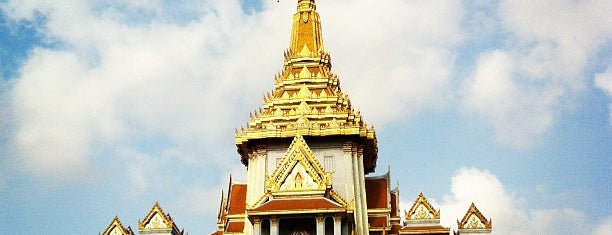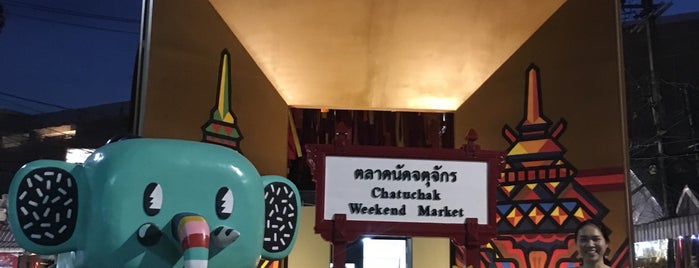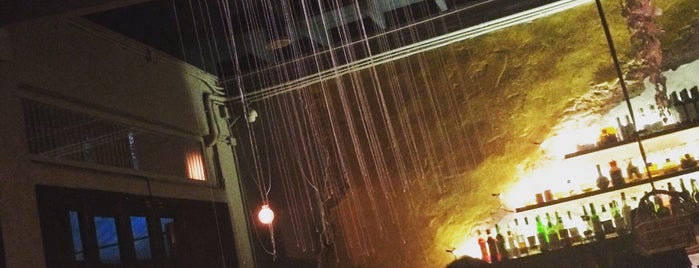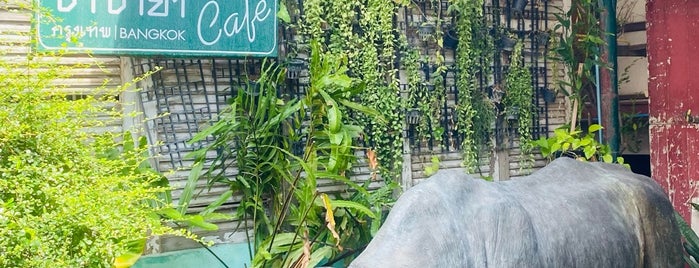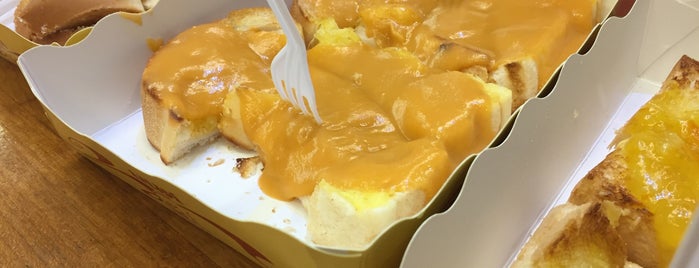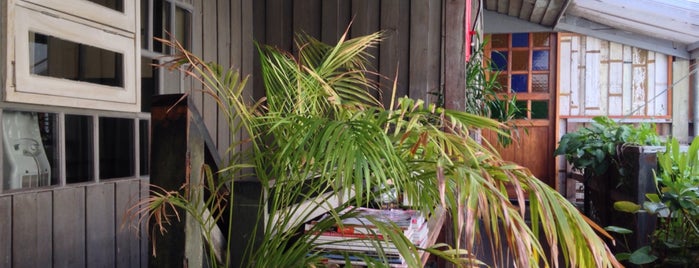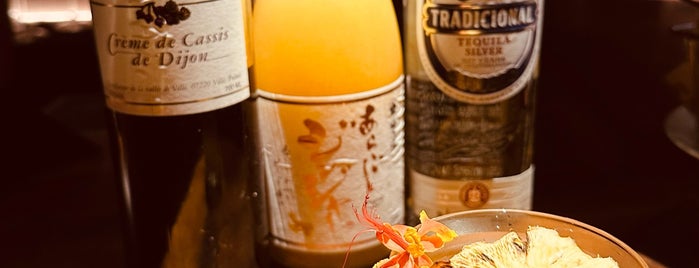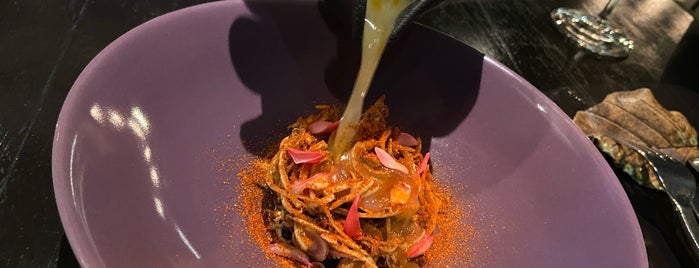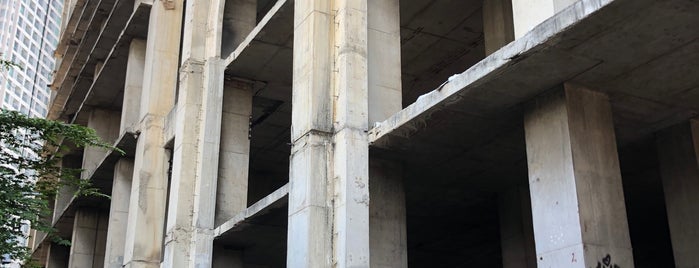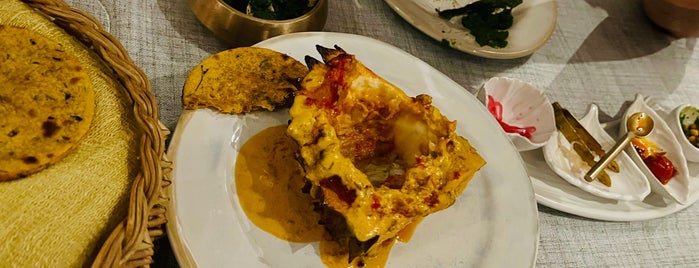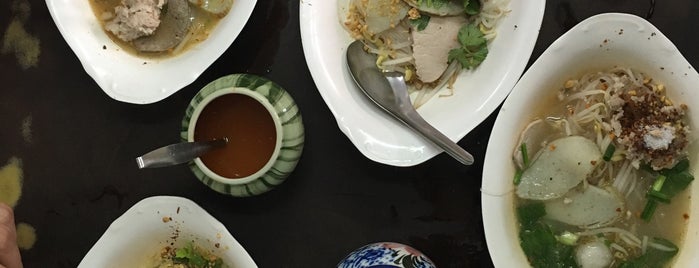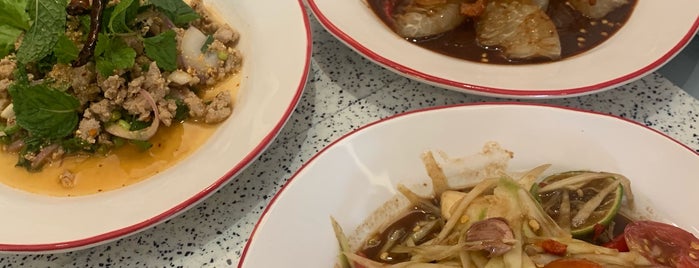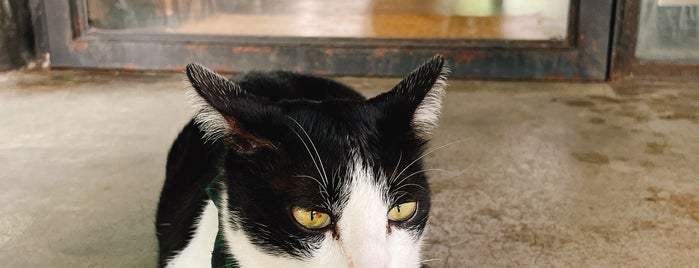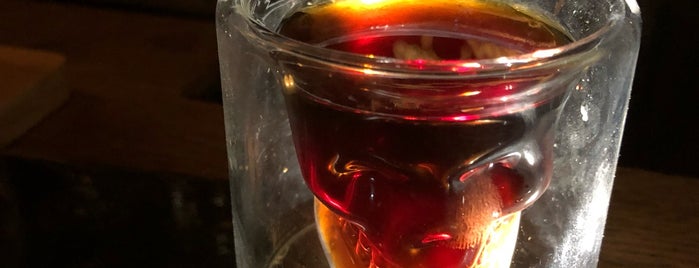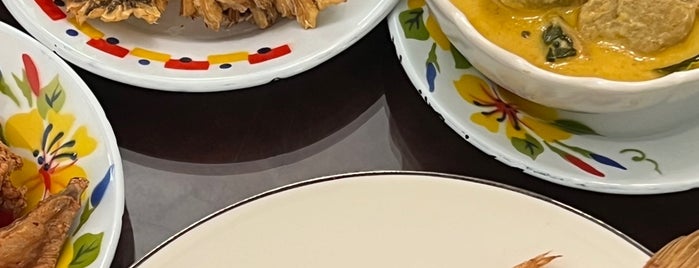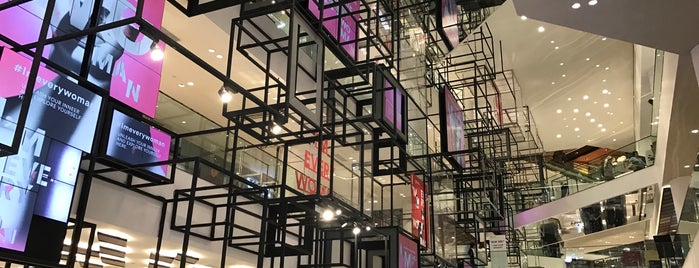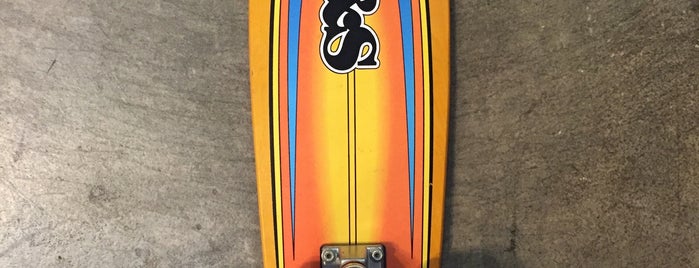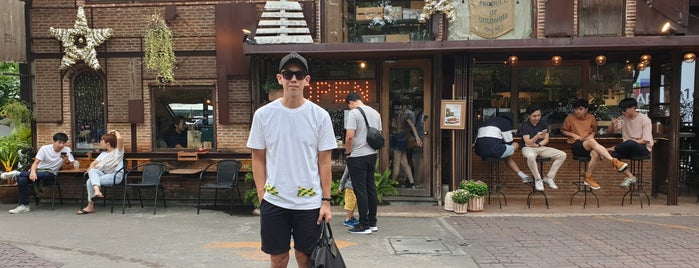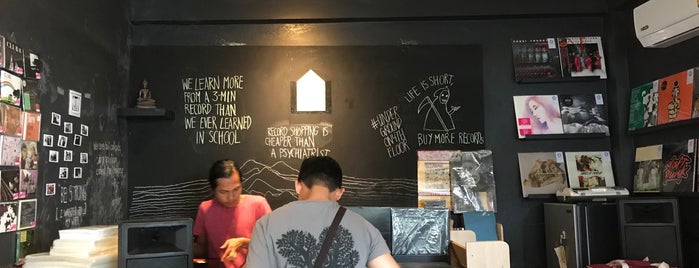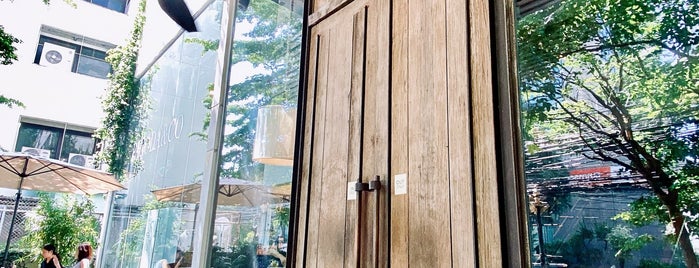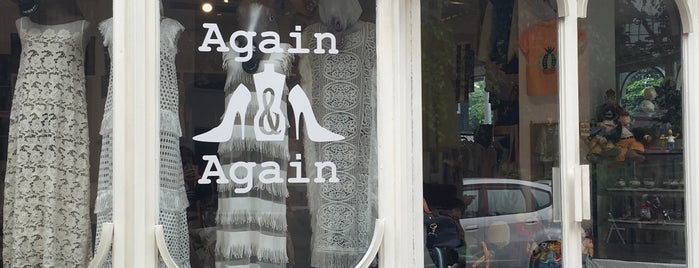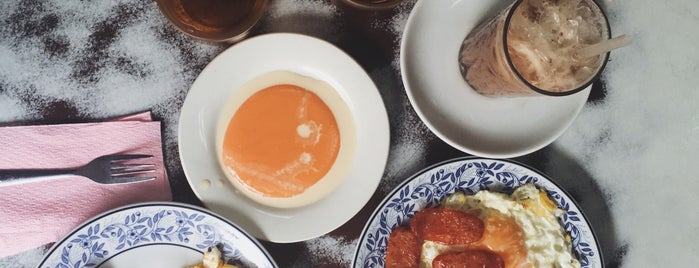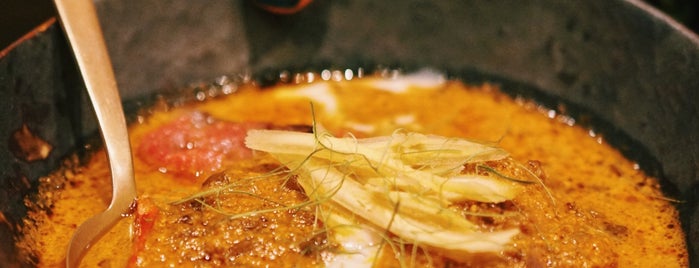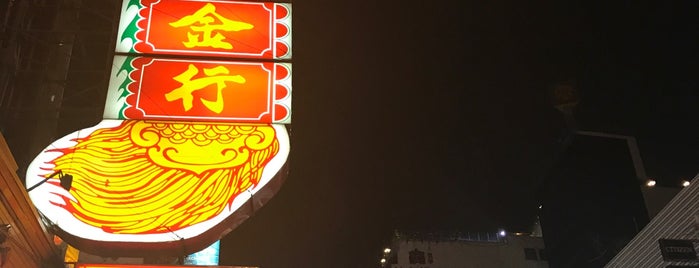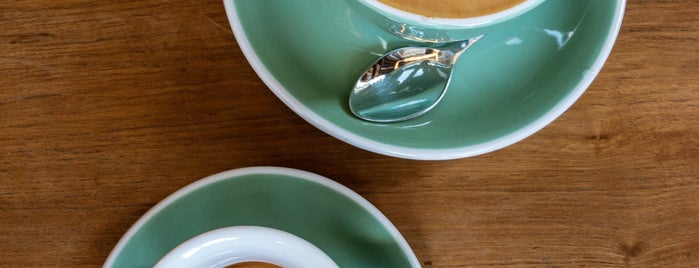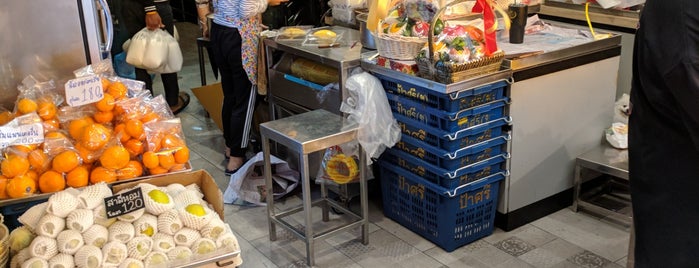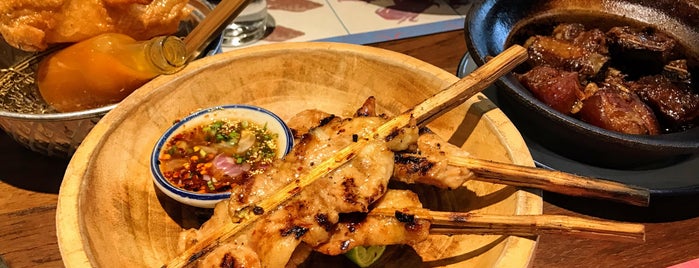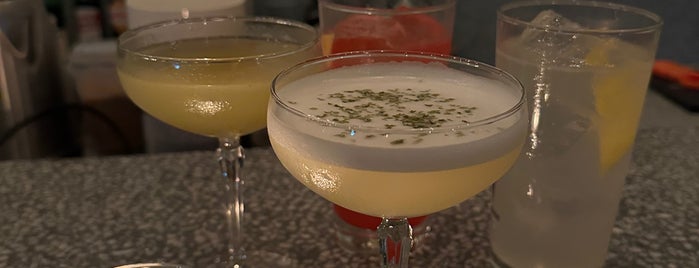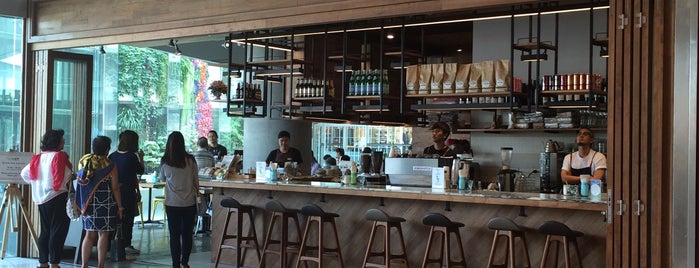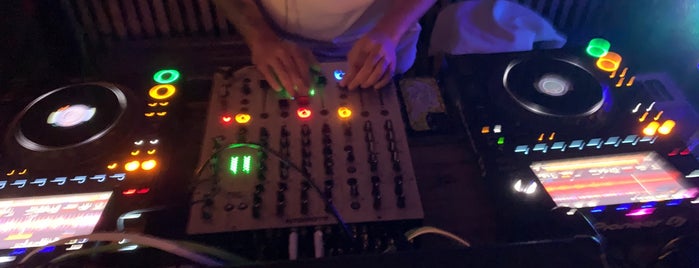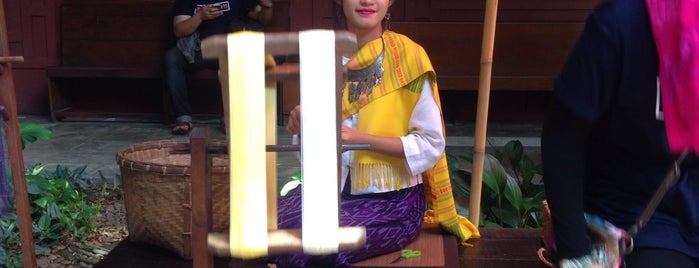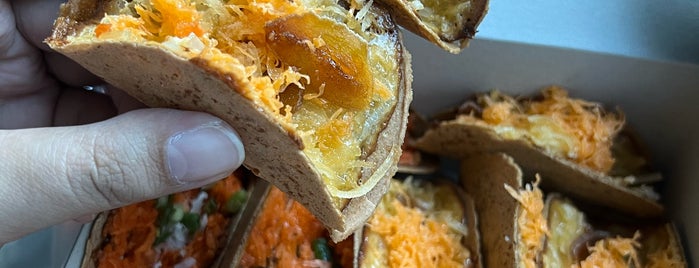Emily: Julia: Only open Saturday/Sundays, an absolute must if you are in BKK over a weekend, imo. Get there early (think they open at 9?), plan to spend at least 3 hours, download and study the app, and read a couple articles that help you come up with a strategy around the different sections. It is organized by category like homewares, clothes, even weird stuff like pets—so optimize for what you want to see. We bought an antique Chinese daybed at Paka Decor and shipped it to the US via one of the many convenient shipping kiosks inside market. We’ll have this piece the rest of our lives, with a cool backstory to boot.
Emily: NYT: The red neon, flickering candles and dark wood at Ba Hao evoke a sultry den from 1930s Shanghai — complete with Opium (a Negroni variant with ginseng, herbal liquor and tiny chrysanthemum bulbs).
Emily: NYT: Thai pride suffuses the cozy, candlelit Tep Bar.Not hungry for fried baby bamboo caterpillars? Try a herbal liquor, rice wine or Nila Pat cocktail (Thai rum, ginger syrup and a black gelatin cube made with Thai herbs) and absorb the traditional Thai music performances. **Good pad Thai (as per Julia).
Emily: NYT (proposed as Chatuchak alternative: A soaring air-conditioned warehouse-shop packed with a museumlike collection of vintage goods: bellows cameras, Jacobsen chairs, barber poles, 1970s computers, claw foot tubs, Oriental rugs, snuff boxes, surgery lamps and so much else — except other shoppers.
Emily: NYT: Mont Nomsod is a Bangkok institution, beloved for its thick white toast spread with sweet toppings (25 baht) like coconut-egg custard, and chunky corn soup.
Emily: NYT: Warehouse 30 ups the neighborhood’s creative quotient with an indie documentary cinema, a gallery-cafe and shops selling everything from steampunk fashion to vintage stereo equipment. NYMag: This has become the new place for young, arty people. It’s cool, lively, and modern, but not pretentious. Aside from the occasional workshop or creative activity, there’s a flower shop [Wallflower], a clothing store [Lonely Two Legged Creature], and a café run by The Fox and The Moon. I particularly like their moon soup, which is a combination of squid ink, crabmeat, and egg yolk. If you want something more filling, go for the cheesy bacon panini. It sounds boring, but it’s hard to find good bread in Bangkok.
Emily: NYT: Inside Sri Trat, Frank Sinatra croons while bartenders in vests pour sly Thai cocktails like the O-Liang (Scotch, port wine, Thai coffee and amaro) for guests ensconced on tufted leather stools. NYMag: “I go here a lot for lunch. Sri Trat serves authentic Eastern Thai food and nice cocktails. The cuisine is well balanced, with a mixture of salty, sour, sweet, and spicy. It also seems more herb-driven, which I love. One dish we always order is the lhon-poo-kai. It is a coconut-milk-based crab dip served with fresh vegetables and herbs — like a Thai crudite.”
Emily: NYT: Thailand meets Tokyo at Salon du Japonisant, where an unmarked door opens into a chic speakeasy outfitted with Chesterfield-style couches, low armchairs and three menus: one for whiskey and Calvados, one for sakes, and one for cocktails. The Old Fashioned 2017 is a dry, spicy and sophisticated blend of Suntory whiskey, green tea bitters, forest bitters, cinnamon stick, orange and Japanese black honey.
Emily: NYMag: For an off-the-beaten-path temple experience, head to Wat Chaichana Songkhram. Built in 1848, during the reign of King Rama III, Chaichana has all the markings of a traditional Thai temple: the ubosot and stupa, multi-tiered roofs, chofa ornamentation, and monks drifting about in orange robes. But it also has a photogenic pavilion hung with Thammachak dharma flags and lined with more than a dozen life-size statues of the Buddha, plus sundry Hindu gods and goddesses.
Emily: Chef Saki Hoshino is arguably the best pastry chef in the city. The restaurant’s menu is constantly changing, but the last time I stopped by, her new dessert was simply called ‘Rice.’ It involved several creative expressions of the grain, including mochi, fermented-rice ice cream, and French tuiles.
Emily: “This small, homey restaurant serves regional food from Southern Thailand. While the dishes cover many Thai food classics, the difference is in the ingredients. When it’s a crab curry (bu pad pong karee), they cook the best crab meat. If it’s stir-fried shrimp with vegetable (pad prik khing goong), then you can be sure the prawns are big and fresh. It’s nothing fancy, but it’s always great to go to a restaurant where you feel as though your own family is cooking.” “An authentic taste of Southern Thai cuisine. My favorite dishes are hot and spicy yellow curry soup with young coconut shoot and high quality seabass (gaeng leung pla krapong) and braised eggs with pork leg and tofu in sweet soy sauce (kai palo). It’s a very homey Thai-Chinese dish, just like Mama used to make! Southern Thai-style green crab curry (gang puu bai chaplu) is also good. It packs in a lot of spices and good-quality crab.”
Emily: “Chinatown is great for street food. The one dish you have to try is toasted custard bread, or kanompang sankaya, on Charoenkrung. It is crispy on the outside and soft inside, and my favorite fillings are orange Thai tea and classic green pandan. The queue for this stand is always very long; both locals and tourists wait up to 30 minutes for their bread.”
Emily: “This hidden gem is situated in the middle of Prasert-Manukitch — which is pretty much nowhere. Because the stand is located in front of my old record label’s office, I managed to eat here almost every day. I’m not a fan of Thai-style noodles, but this stand changed my mind. I recommend the tom yum pork egg noodle soup, or ba mee moo tom yum naam. They put curly batter-fried fish snacks on the noodles, and the result is amazing! Make sure to order extra by saying ‘kor perm taro tord.’”
Emily: “If you don’t want to do Thai fine dining at the Michelin-starred Nahm or its successor Bo.lan, this is the place to go. Great Thai food in a semi-casual, nicely designed interior. Not too pretentious, while maintaining top-notch service. Go with any of the chef-recommended dishes, like pad nam prik sataw goong sod [Southern-style stink beans stir-fried with prawns and shrimp paste] and pad ka nah pla kem koh chang [Chinese kale stir-fried with fish sauce]. Don’t forget to order the dumpling in coconut milk for dessert, either. I’d give them five stars based on that alone.”
Emily: “The specialty here is five-spiced, braised duck soup with your choice of noodles and parts (necks, beaks, blood, livers, wings, gizzards, etc.). The broth is rich, salty, and sweet; you add your own chilis and vinegar to round it off. If you’re more of a goose person, Chua Kim Heng braises theirs in a Chinese-style broth, and it’s a little ‘fleshier.’ Again, you choose the parts you want and it’ll be served sliced with braising liquid on a plate. Get a bowl of rice with it and use the fermented orange chili and garlic sauce for dipping the goose. Order a side of pickled mustard greens, too; they rock.”
Emily: “For a fine-dining experience, you can’t beat Gaa. It’s totally overlooked, but bloody amazing — an ever-changing tasting menu, with inspiring attention to detail. The food is a reflection of chef Garima Arora’s own personal journey and background. There are Indian elements and Nordic nods, but everything on the plate is sourced in Thailand.”
Emily: “When it comes to ‘proper’ restaurants in Bangkok, it’s hard to keep up with everything; they open and close at a frantic rate. Thai Niyom recently opened at the Mahatun Plaza, right at the Phloen Chit BTS station. It’s a tiny place with bright blue walls and a quirky design; the polished wood furniture was inherited from a previous tenant. The menu focuses on Thai comfort food and dishes typically cooked at home. The green curry with beef — quite rare, as it is usually made with chicken — is delicious and the stir-fried cabbage is the best I’ve had in Thailand.”
Emily: “Saew Noodles [on Sukhumvit Soi 49] is a morning-to-lunch spot. What makes it so special is the quality of their fish balls and the pork offal they select. Their spicy tom yum noodles are well-seasoned to Thai-Chinese taste; it’s no wonder there’s always a long queue of people during lunch. I recommend ordering this dish dry to get more of the tom yum intensity in the noodles. The soup is good on the side without adding anything to it — very delicate and mild. To order this in Thai, say either ‘ba mee tom yum haeng’ [for egg noodles] or ‘sen lek tom yum haeng’ [for rice noodles]. As for toppings, I prefer fried fish skin. It’s available as a snack pack on the table for a little extra.”
Emily: “It offers traditional Isaan food — Northeastern Thai classics like papaya salad. The must-have dishes here are the grilled pork neck (kor moo yang); the raw ocean crab salad, chilled with lots of garlic, chili, and lime (yam poo talay kai); and the grilled Thai mussels with papaya on the side (hoy seab malagor). The restaurant is clean, the food isn’t too sweet, and there are a good variety of dishes on the menu.”
Emily: It’s a creative arts complex with its own gallery, a bookstore/café [Candide], two restaurants [The Never Ending Summer and The Summer House Project], and a home décor shop [anyroom]. I adore The Never Ending Summer’s high ceilings and striking interior, which look very industrial. The food there is different from other places, too; it feels like home cooking with a twist. I love how fresh the vegetables are and the quality of ingredients. The Jam Factory was founded by Duangrit Bunnag, an award-winning architect—also the founder of Warehouse 30.
Emily: It’s a strange combination — both casual café and diving center! The place feels very untouched by the modern world. You can still see a portrait painting of King Rama I hanging in there.
Emily: Ignore the interior design; your mission is to get up to the rooftop for an amazing view, where you can grab a beer and enjoy the sunset.”
Emily: Your ideal evening would kick off with dinner at 100 Mahaseth, Chef Chalee Kader’s temple to Thai nose-to-tail dining. You can feast on salt-cured pork chops while drinking yaa dong, a fiery Thai spirit, or an ice-cold Singha on tap.
Emily: Jack’s ticks all the right boxes: a great location right on the river, open till 4 a.m., cheap cocktails and beer, and delicious late-night Thai comfort food.
Emily: By contrast, the Bangkokian Museum, a.k.a. Bangkok Folk Museum, receives but a fraction of the visitors. Entry is free, tours are self-guided, and the property, while not as prominent as Thompson’s, is just as interesting. Two beautifully preserved houses, one Eastern and one Western in style, are surrounded by gardens and decorated with objects that show how well-heeled locals would have lived circa World War II. It’s the little details that matter here: the chipped-up porcelain sinks, the latticed wood ceilings, the yellowed keys of an upright piano. And because you can move at your own pace, you’ll actually have time to appreciate them.
Emily: For 300 baht less per ticket ($16.02 versus $6.40), you can explore the country’s largest collection of Thai art and artifacts, including chariots used for royal cremations, menacing khon masks, elaborate ceremonial costumes, and other deep cuts from His Majesty King Rama V’s archive of antiquities. Avant-garde architect Sanitas Pradittasnee agrees: “My favorite day trip is a quiet walk in the National Museum; there are loads of invaluable artifacts from the past that I find new inspiration in.”
Emily: Bar crawl: Start with a dried-banana-infused gin & tonic at the 16-seat bar Teens of Thailand; chase that with Thai craft beers soundtracked by traditional live music at Tep Bar; then wrap up with duck wontons and Chinese-inspired cocktails at Bà Hāo, where ingredients like star anise, mashed plum, and roselle take center stage.
Emily: Here, departments are called “labs” and the flagship brands are hi-so hip (Kenzo, Tsumori Chisato, Comme de Garçons). Much of the floor space is open-plan, giving it a modern, airy feel. (You can thank award-winning Japanese design firm Nendo for that.) Head to the higher floors for beautiful ceramics, shibori-dyed pillow cases, and limited-edition art prints by Thai illustrators (Objects of Desire); imported Japanese cosmetics and stationery (Loft); and sculptural chairs fashioned from seatbelts by Thai designer Nuttapong Charoenkitivarakorn. It’s impossible to leave empty-handed.
Emily: “One of my favorite spas in Bangkok is actually a Japanese onsen. You pay a flat price to get in and can spend all day in the sauna or getting special treatments like a yuzu bath. There’s also a Japanese restaurant on-site, where you can take a break, relax, and order tea and lighter food like soba noodles.”
Emily: “I don’t usually wear T-shirts, but I collect the ones related to punk history and frame them as art pieces. This Ekkamai barbershop sells old designs from The Sex Pistols, Vivienne Westwood, and cool ’80s rock bands. I also found a rare Mickey Mouse shirt here once.”
Emily: “Another Ekkamai favorite. They carry vintage leather goods like shoes, boots, bags, and jackets, plus premium leather-care products. Customers can also drink coffee and read magazines in their next-door café.”
Emily: “This place never disappoints when I want to buy records from the ’70s, ’80s, and ’90s. The owner is well connected with a dealer from Japan, so if I really want something, he’ll usually find it for me. I got the original 1974 European pressing of Miles Davis’s Big Fun album from here, as well as a free-jazz record, Chiasma, from the Yosuke Yamashita Trio.”
Emily: “This stylish furniture shop carries a mix of vintage collectibles and modern items from designers and artists. You can find everything from an old top hat to a big chandelier, plus bar top accessories like a candle holder, ashtray, and ice bucket.”
Emily: “Lots of bohemian styles from the 1970s here, along with new embroidered caftans and cotton pieces with resort vibes. It’s mostly vintage, though. Like, I once got a knit dress with cotton and Lurex fringe all over. It’s so fancy-looking, but it has a relaxed attitude and is easy to take care of.”
Emily: “This shop carries mostly designer pieces — bags, leather goods, and some jewelry — from Chanel, Hermès, Gucci, and other big names.”
Emily: Andy Ricker: Check out On Lok Yun to see a Thai interpretation of Western breakfast, including wok-fried French toast and ham and eggs.
Emily: Andy Ricker: The Never Ending Summer offers dishes such as chile and kaffir lime fried chicken wings and vibrant duck curry in a loft space overlooking the river.
Emily: Andy Ricker: Bo.Lan combines super-traditional curries with a focus on high-quality ingredients and technique. The refined menu is constantly changing, and it even has a few Thai wines from the north if you want to try something new.
Emily: Mikey: linked to Bo.Lan, near one of the big tourist-y temple sites - drinking snacks/street food but small plate elevated stuff
Emily: Oscar: Noodle food stand. Get the broth less one. Probably the best noodles I’ve ever had
Emily: Julia: 100% worth a visit; tour is required but only 35 minutes and just visually stunning to be in this space.
Emily: Eater: Located in the old quarter of Bangkok known as Rattanakosin Island, Somsong is a favorite mom-and-pop famous for serving Thai food not typically found outside the home. You'll have plenty of choices here: Go for Sukhothai noodles (rice noodle with pork broth and string beans), a variety of Thai curries and rice, daily one-plate meal specials, and fantastic Thai desserts like khao fang (young rice pudding), durian and sticky rice (seasonal). Try one of everything if you can, and don't leave without getting the rice with shrimp paste. [$]
Emily: Eater: A charming old-school cafe that has been around for more than 60 years, the original Hia Tai Kee retains its vintage ambiance, even after opening in multiple locations. Sip freshly brewed Thai-style coffees (served with condensed milk and complimentary Chinese tea) at round marble-top tables, or try one of the newer drinks like an iced latte. If you're hungry, try the delightfully greasy Chinese-Western breakfast of fried eggs, Chinese sausages cooked and served in a pan, and a small portion of banh mi. [$]
Emily: Eater: Krua Apsorn is the place to go for a hearty Thai meal when strolling in the old town of Ratanakosin. The decadent crab omelet is an all-time favorite; round out an order with stir-fried crab with string beans and yellow chilies, river prawns with garlic, and a bowl of sour lotus stem and prawn soup. Do not skip the signature coconut sorbet for dessert, either. Krua Apsorn has a couple of outposts in Bangkok, but pick the Dinso Road location for a convenient meal near the city center. [$$]

